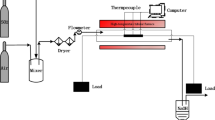Abstract
We established the influence of tensile stresses that vary from zero to 1.2 times theyield limit of the material on the intensity of electrochemical dissolution of St20 steel in corrosive media with various values of pH (3.6, 6.9, and 10.4). It is shown that the maximum intensification of dissolution is attained in processes of initiation and development of plastic yield in subsurface layers of the material. By the rotating disk electrode method, we analyzed samples of corrosive media and determined both the total yield of iron ions and the yield of each product of dissolution (Fe2+ and Fe3+ ions and their compounds).
Similar content being viewed by others
References
H. L. Logan,Metal Corrosion under Stress [Russian translation], Metallurgiya, Moscow (1970).
M. Keddam and J. Vieira da Silva, “The influence of straining on the anodic behaviour of iron in an acidic medium,”Cor. Sci.,20, No. 20, 167–175 (1980).
O. I. Steklov,Corrosion Resistance of Materials and Structures under Stress [in Russian], Mashinostroenie, Moscow (1990).
L. I. Freiman, V. A. Makarov, and I. N. Bryskin,Potentiostatic Methods in Corrosion Research and Electrochemical Protection, Khimiya, Leningrad (1972).
M. R. Tarasevich, E. I. Khrushcheva, and V. Yu. Filinovskii,Rotating Disk Electrode with a Ring [in Russian], Nauka, Moscow (1987).
V. V. Panasyuk, A. E. Andreikiv, and V. S. Parton,Fundamentals of Fracture Mechanics, Vol. 1 of: V. V. Panasyuk (editor),Fracture Mechanics and Strength of Materials: A Handbook [in Russian], Naukova Dumka, Kiev (1988).
V. T. Troshchenko, V. V. Pokrovskii, and A. V. Prokopenko,Cracking Resistance of Metals under Cyclic Loading [in Russian], Naukova Dumka, Kiev (1987).
A. Pourbaix, “Localized corrosion: behaviour and protection mechanism,” in:Corrosion Chemistry. Pits, Crevices, and Cracks: Proceedings of the Conference (Teddington, 1984), London (1987), pp. 1–13.
G. M. Florianovich, “Mechanism of active dissolution of iron group metals,” in:Itogi Nauki i Tekhniki, Ser. Corrosion and Corrosion Protection [in Russian], Vol. 6, VINITI, Moscow (1978), pp. 136–180.
T. Misava, K. Hashimoto, and S. Shimodaira, “The mechanism of formation of iron oxide and oxyhydroxides in aqueous solution at room temperature,”Cor. Sci.,14, No. 8, 131–149 (1974).
Additional information
Karpenko Physicomechanical Institute, Ukrainian Academy of Sciences, L'viv. Translated from Fiziko-Khimicheskaya Mekhanika Materialov, Vol. 30, No. 1, pp. 64–69, January–February, 1994.
Rights and permissions
About this article
Cite this article
Dmytrakh, I.M., Ezers'ka, O.A. Special features of the electrochemical dissolution of a loaded surface of St20 steel. Mater Sci 30, 61–65 (1995). https://doi.org/10.1007/BF00559018
Received:
Issue Date:
DOI: https://doi.org/10.1007/BF00559018




